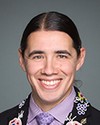I'm toggling through my mind to decide where to start.
I'll give you a quick little testimony. We have a lady who's very near and dear to us, Marguerite Peecheemow. She's in her mid-eighties. She grew up in Fox Lake. That's one of those communities you have to barge across or fly across to, or wait for the winter road to be built.
She was at the long-term care facility in La Crete, which distanced her by about three or four hours from her core family and friendship group. Because of, if I can be so bold as to say so, a lack of cultural inclusivity, many of us would travel to La Crete to spend time with her in lieu of her family, who were not able to make it because of economic conditions and problems of accessibility.
I'll say it this way. She gracefully broke her hip, and they had to move her into Fort Vermilion. She is actually much happier, because she is a bit closer to her family.
The broken hip came because of overstuffed facilities, according to her testimony, and people not being able to really get to her and look after her. As I said earlier, we have staff shortages. One of our three recommendations is to look at how we can bring more education and training into the area. It's a kind of cumulative effect that has caused people such as Mrs. Peecheemow to sustain hip injuries.
I was talking to one of her family members just a couple of weeks ago. They would love nothing more than to be much closer to Marguerite. The reality is that many first nations might not even have a car, and to be able to see their family, even from two or three hours away let alone nine hours away, can sometimes be an impossibility. In talking to this person, I found they hadn't seen their own mom for two and a half years, and that's just within the region, let alone considering cases out of the region.
I don't know how else to say it to you. I know I'm getting caught up in the passionate anecdotal type of stuff here, but that's what I would like to share on that, Rachel.




